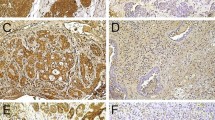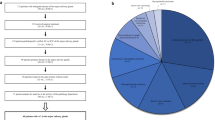Abstract
Objectives
The aim of this study was to investigate the predictive value of the biomarkers FHIT, p27, and pERK1/ERK2 in salivary gland carcinomas.
Material and methods
Immunohistochemical staining of FHIT, p27, and pERK1/ERK2 of 265 patients with salivary gland carcinomas was conducted, and associations with clinico-histopathological data, overall survival, and disease-specific survival were examined.
Results
Expression of FHIT (quick score 98.7 vs. 206.4) and p27 (QS 187.3 vs. 244.8) was significantly lower in carcinomas compared to non-tumor control tissue. Loss of FHIT frequently occurred in ACC (55.2%), SDC (68.2%), and SCC (100%). In the totality of tumors, loss of FHIT expression was found in 46.7% (106/227) and was significantly associated with advanced T stage and UICC stage, high-grade histology, loss of p27, PI3K, and survivin. FHIT positivity went along with significantly better overall and disease-specific survival. Negativity of p27 occurred in 28.7% (70/244) of tumors, particularly in SDC (54.4%) and SCC (50%). In the totality of tumors, p27 was associated with advanced patient age, high-grade histology, PI3K, survivin as well as better overall and disease-specific survival (p < 0.05). Positive pERK1/ERK2 expression correlated with positive survivin expression but did not affect overall survival in the totality of tumors. In mucoepidermoid carcinomas, pERK1/ERK2 expression was associated with low-grade malignancy, positive nuclear survivin, and better disease-specific survival.
Conclusions
Loss of FHIT and p27 characterizes aggressive tumor growth and unfavorable prognosis in salivary gland cancer.
Clinical relevance
The results may help to stratify patient-specific therapies according to individual tumor characteristics.


Similar content being viewed by others
References
Speight P, Barrett A (2002) Salivary gland tumours. Oral Dis 8:229–240
El-Naggar AK (2017) What is new in the World Health Organization 2017 histopathology classification? Curr Treat Options in Oncol 18:43. https://doi.org/10.1007/s11864-017-0469-x
Pekarsky Y, Zanesi N, Palamarchuk A, Huebner K, Croce CM (2002) FHIT: from gene discovery to cancer treatment and prevention. Lancet Oncol 3:748–754. https://doi.org/10.1016/s1470-2045(02)00931-2
Dincer N, Tezel GG, Sungur A, Himmetoglu C, Huebner K, Guler G (2010) Study of FHIT and WWOX expression in mucoepidermoid carcinoma and adenoid cystic carcinoma of salivary gland. Oral Oncol 46:195–199. https://doi.org/10.1016/j.oraloncology.2009.12.003
Semba S, Trapasso F, Fabbri M, McCorkell KA, Volinia S, Druck T, Iliopoulos D, Pekarsky Y, Ishii H, Garrison PN, Barnes LD, Croce CM, Huebner K (2006) Fhit modulation of the Akt-survivin pathway in lung cancer cells: Fhit-tyrosine 114 (Y114) is essential. Oncogene 25:2860–2872. https://doi.org/10.1038/sj.onc.1209323
Okabe M, Inagaki H, Murase T, Inoue M, Nagai N, Eimoto T (2001) Prognostic significance of p27 and Ki-67 expression in mucoepidermoid carcinoma of the intraoral minor salivary gland. Mod Pathol 14:1008–1014
Chu IM, Hengst L, Slingerland JM (2008) The Cdk inhibitor p27 in human cancer: prognostic potential and relevance to anticancer therapy. Nat Rev Cancer 8:253–267. https://doi.org/10.1038/nrc2347
Ben-Izhak O, Akrish S, Gan S, Nagler RM (2009) p27 and salivary cancer. Cancer Immunol Immunother 58:469–473. https://doi.org/10.1007/s00262-008-0547-9
Handra-Luca A, Ruhin B, Lesty C, Fouret P (2006) P27, SKP2, and extra-cellular signal-related kinase signalling in human salivary gland mucoepidermoid carcinoma. Oral Oncol 42:1005–1010. https://doi.org/10.1016/j.oraloncology.2005.12.022/c
Donovan JC, Milic A, Slingerland JM (2001) Constitutive MEK/MAPK activation leads to p27(Kip1) deregulation and antiestrogen resistance in human breast cancer cells. J Biol Chem 276:40888–40895. https://doi.org/10.1074/jbc.M106448200
Burotto M, Chiou VL, Lee JM, Kohn EC (2014) The MAPK pathway across different malignancies: a new perspective. Cancer 120:3446–3456. https://doi.org/10.1002/cncr.28864
Barnes L, Eveson J, Reichart P, Sidransky D (2005) Pathology and genetics of head and neck tumours. World Health Organization classification of Tumours. IARC, Lyon
Ettl T, Schwarz-Furlan S, Haubner F, Müller S, Zenk J, Gosau M, Reichert TE, Zeitler K (2012) The PI3K/AKT/mTOR signalling pathway is active in salivary gland cancer and implies different functions and prognoses depending on cell localisation. Oral Oncol 48:822–830
Ettl T, Stiegler C, Zeitler K, Agaimy A, Zenk J, Reichert TE, Gosau M, Kühnel T, Brockhoff G, Schwarz S (2012) EGFR, HER2, survivin, and loss of pSTAT3 characterize high-grade malignancy in salivary gland cancer with impact on prognosis. Hum Pathol 43:921–931
Milanes-Yearsley M, Hammond ME, Pajak TF, Cooper JS, Chang C, Griffin T, Nelson D, Laramore G, Pilepich M (2002) Tissue micro-array: a cost and time-effective method for correlative studies by regional and national cancer study groups. Mod Pathol 15:1366–1373. https://doi.org/10.1097/01.MP.0000036345.18944.22
Laurent-Puig P, Cayre A, Manceau G, Buc E, Bachet JB, Lecomte T, Rougier P, Lievre A, Landi B, Boige V, Ducreux M, Ychou M, Bibeau F, Bouche O, Reid J, Stone S, Penault-Llorca F (2009) Analysis of PTEN, BRAF, and EGFR status in determining benefit from cetuximab therapy in wild-type KRAS metastatic colon cancer. J Clin Oncol 27:5924–5930. https://doi.org/10.1200/JCO.2008.21.6796
Cao J, Li W, Xie J, Du H, Tang W, Wang H, Chen X, Xiao W, Li Y (2006) Down-regulation of FHIT inhibits apoptosis of colorectal cancer: mechanism and clinical implication. Surg Oncol 15:223–233. https://doi.org/10.1016/j.suronc.2007.01.006
Woenckhaus M, Merk J, Stoehr R, Schaeper F, Gaumann A, Wiebe K, Hartmann A, Hofstaedter F, Dietmaier W (2008) Prognostic value of FHIT, CTNNB1, and MUC1 expression in non-small cell lung cancer. Hum Pathol 39:126–136. https://doi.org/10.1016/j.humpath.2007.05.027
Dumon K, Ishii H, Vecchione A, Trapasso F, Baldassarre G, Chakrani F, Druck T, Rosato E, Williams N, Baffa R, During M, Huebner K, Croce C (2001) Fragile histidine triad expression delays tumor development and induces apoptosis in human pancreatic cancer1. Cancer Res 61:4827–4836
Huang Q, Liu Z, Xie F, Liu C, Shao F, Zhu CL, Hu S (2014) Fragile histidine triad (FHIT) suppresses proliferation and promotes apoptosis in cholangiocarcinoma cells by blocking PI3K-Akt pathway. ScientificWorldJournal 2014:179698. https://doi.org/10.1155/2014/179698
Li F, Yang J, Ramnath N, Javle MM, Tan D (2005) Nuclear or cytoplasmic expression of survivin: what is the significance? Int J Cancer 114:509–512. https://doi.org/10.1002/ijc.20768
Zhao P, Meng Q, Liu LZ, You YP, Liu N, Jiang BH (2010) Regulation of survivin by PI3K/Akt/p70S6K1 pathway. Biochem Biophys Res Commun 395:219–224. https://doi.org/10.1016/j.bbrc.2010.03.165
Sarli L, Bottarelli L, Azzoni C, Campanini N, Di Cola G, Barilli AL, Marchesi F, Mazzeo A, Salvemini C, Morari S, Di Mauro D, Donadei E, Necchi F, Roncoroni L, Bordi C (2006) Loss of p27 expression and microsatellite instability in sporadic colorectal cancer. Surg Oncol 15:97–106. https://doi.org/10.1016/j.suronc.2006.09.002
Handra-Luca A, Bilal H, Bertrand J-C, Fouret P (2003) Extra-cellular signal-regulated ERK-1/ERK-2 pathway activation in human salivary gland Mucoepidermoid carcinoma. Am J Pathol 163:957–967. https://doi.org/10.1016/s0002-9440(10)63455-4
Deschenes-Simard X, Kottakis F, Meloche S, Ferbeyre G (2014) ERKs in cancer: friends or foes? Cancer Res 74:412–419. https://doi.org/10.1158/0008-5472.CAN-13-2381
Milde-Langosch K, Bamberger AM, Rieck G, Grund D, Hemminger G, Muller V, Loning T (2005) Expression and prognostic relevance of activated extracellular-regulated kinases (ERK1/2) in breast cancer. Br J Cancer 92:2206–2215. https://doi.org/10.1038/sj.bjc.6602655
Lujan B, Hakim S, Moyano S, Nadal A, Caballero M, Diaz A, Valera A, Carrera M, Cardesa A, Alos L (2010) Activation of the EGFR/ERK pathway in high-grade mucoepidermoid carcinomas of the salivary glands. Br J Cancer 103:510–516. https://doi.org/10.1038/sj.bjc.6605788
Chen X, Duan N, Zhang C, Zhang W (2016) Survivin and tumorigenesis: molecular mechanisms and therapeutic strategies. J Cancer 7:314–323. https://doi.org/10.7150/jca.13332
Ettl T, Baader K, Stiegler C, Muller M, Agaimy A, Zenk J, Kuhnel T, Gosau M, Zeitler K, Schwarz S, Brockhoff G (2012) Loss of PTEN is associated with elevated EGFR and HER2 expression and worse prognosis in salivary gland cancer. Br J Cancer 106:719–726. https://doi.org/10.1038/bjc.2011.605
Ettl T, Schwarz S, Kleinsasser N, Hartmann A, Reichert TE, Driemel O (2008) Overexpression of EGFR and absence of C-KIT expression correlate with poor prognosis in salivary gland carcinomas. Histopathology 53:567–577. https://doi.org/10.1111/j.1365-2559.2008.03159.x
Ach T, Zeitler K, Schwarz-Furlan S, Baader K, Agaimy A, Rohrmeier C, Zenk J, Gosau M, Reichert TE, Brockhoff G, Ettl T (2013) Aberrations of MET are associated with copy number gain of EGFR and loss of PTEN and predict poor outcome in patients with salivary gland cancer. Virchows Arch 462:65–72. https://doi.org/10.1007/s00428-012-1358-0
Acknowledgements
We wish to thank Rudolf Jung for his excellent immunohistochemical stainings.
Author information
Authors and Affiliations
Corresponding author
Ethics declarations
Conflict of interest
The authors declare that they have no conflict of interest.
Ethical approval
The study has been performed in accordance with the ethical standards as laid down in the 1964 Declaration of Helsinki and its later amendments or comparable ethical standards.
Informed consent
For this type of study, formal consent is not required.
Additional information
Publisher’s Note
Springer Nature remains neutral with regard to jurisdictional claims in published maps and institutional affiliations.
Rights and permissions
About this article
Cite this article
Fiedler, M., Renner, P., Schubert, J. et al. Predictive value of FHIT, p27, and pERK1/ERK2 in salivary gland carcinomas: a retrospective study. Clin Oral Invest 23, 3801–3809 (2019). https://doi.org/10.1007/s00784-019-02809-z
Received:
Accepted:
Published:
Issue Date:
DOI: https://doi.org/10.1007/s00784-019-02809-z




